#al'ud
Explore tagged Tumblr posts
Text
history of guitars
⋘ 𝑃𝑙𝑒𝑎𝑠𝑒 𝑤𝑎𝑖𝑡… ⋙
Note: I have cross checked my information and researched to the best of my ability though I am human and not immune to error if there are any mistakes please let me know and I will correct it
⋘ 𝑙𝑜𝑎𝑑𝑖𝑛𝑔 𝑑𝑎𝑡𝑎… ⋙
The origins of the guitar are unknown and can possibly bee traced back to over 4000 years with carvings of stringed images have appeared in the Mesopotamian and Babylonian Empires.
It is often claimed that the guitar was developed from the lute or the kithara from ancient Greece, but research by Dr. Michael Kasha in the 1960's showed that the lute is a result of a separate line of development sharing common ancestors with the guitar but not having influence on its evolution. And the only evidence for the kithara theory is the similarity between the Greek word "kithara" and the Spanish word "quitarra".
The kithara was a actually a different type of instrument being more like a lap harp or lyre as shown bellow.
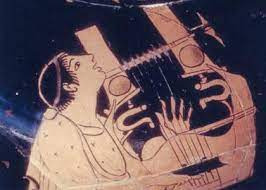
There is a plucked stringed instrument that closely resembles a guitar can be seen in a picture painted in Egypt around 3000 B.C as shown below.
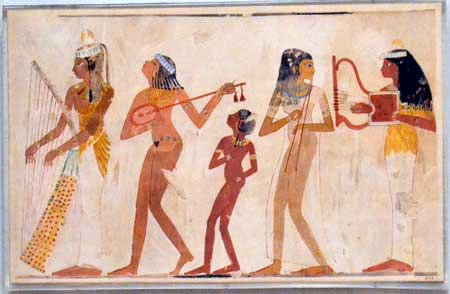
However there is no material available on how this instrument developed after the picture was painted to support this theory. But a 3500 year old guitar was found in Egypt belonging to a singer named Har-Mose and was found in his grave right next to him, so he could play it in the other life.
The instrument resembles more of a tanbur than a guitar but is the closest thing to a modern guitar to that point in history.
Har-Moses guitar had three strings and a plectrum suspended from the neck by a cord. The soundbox was made of polished cedarwood and had a rawhide "soundboard". You can see it at the Archaeological Museum in Cairo. A picture of Har-Moses guitar below.
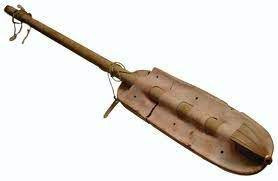
The earliest stringed instruments known to archaeologists are bowl harps (or bowl lyre) and tanburs. Both are shown below in order of mention.
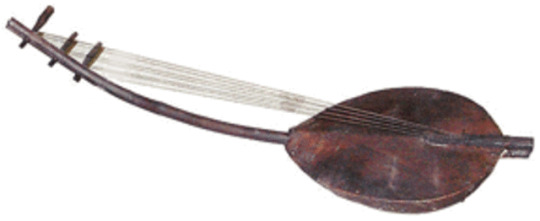
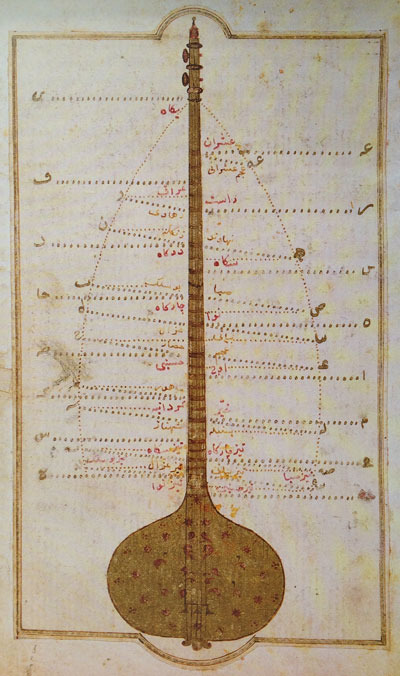
Bowl harps were made from tortoise shells and calabashes as resonators, with a bent stick for a neck and one or more gut or silk strings. They first appeared around 3000 B.C in Iran and Mesopotamia and then in Egypt. They were widespread in the ancient Middle East.
The tanbur is defined as "a long-necked stringed instrument with a small egg- or pear-shaped body, with an arched or round back, usually with a soundboard of wood or hide, and a long, straight neck". It has been present in Mesopotamia since the Akkadian era, or the third millennium B.C.
Other "guitars" in history are the oud and lute. Shown below.
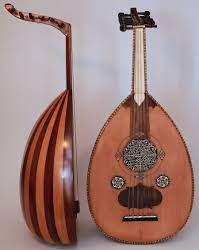
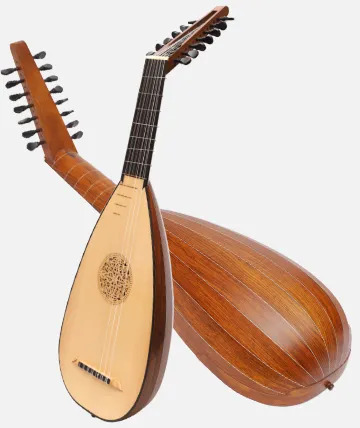
The Lute was bought to Spain by the Moors in the 13th century. The tanbur had taken another line of development in the Arabian countries, changing in its proportions.
The Europeans added frets to the oud and called it a "lute" derived from the Arabic "Al'ud" (literally "the wood") via the Spanish name "laud". A lute or oud is defined as a "short-necked instrument with many strings, a large pear-shaped body with highly vaulted back, and an elaborate, sharply angled peg head".
The word "guitar" comes from chartar" Old Persian meaing "four strings" and "tar" the ancient Sanskrit word for "string".
Many stringed folk instruments exist in Central Asia to this day which have been used in almost unchanged form for several thousand years, shown by archeological finds in the area. Many have names that end in "tar", with a prefix indicating the number of strings.
The early ancestors to the modern guitar most often had four strings with variations with from three to five strings and can be seen in medieval illustrated manuscripts and carved in stone in churches and cathedrals, from Roman times through till the Middle Ages.
By the beginning of the Renaissance, the four-course (4 unison-tuned pairs of strings) guitar had become dominant in most of Europe.
The earliest known music for the four-course "chitarra" was written in 16th century Spain. The five-course guitarra battente first appeared in Italy at around the same time, and gradually replaced the four-course guitar. The standard tuning had already settled at A, D, G, B, E, like the top five strings of the modern guitar. Guitarra battente shown bellow.
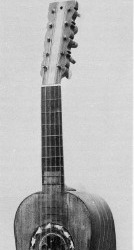
In common with lutes, early guitars seldom had necks with more than 8 frets free of the body, but as the guitar evolved, this increased first to 10 and then to 12 frets to the body.
A sixth course of strings was added to the Italian "guitarra battente" in the 17th century, and guitar makers around Europe followed the trend. The six-course arrangement gradually gave way to six single strings.
In the transition from five courses to six single strings, it seems that at least some existing five-course instruments were modified to the new stringing pattern. This was a fairly simple task, as it only entailed replacing (or re-working) the nut and bridge, and plugging four of the tuning peg holes.
An incredibly ornate guitar by Joakim Thielke a master from Hamburg, Germany (1641 - 1719), was altered in this way. Note that this instrument has only 8 frets free of the body.
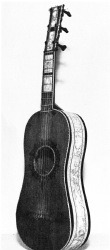
At the beginning of the 19th century the modern guitar eas beginning to take shape, the bodies were still fairly small and narrow-waisted.
The modern "classical" guitar took its present form when the Spanish maker Antonio Torres increased the size of the body, altered its proportions, and introduced the revolutionary "fan" top bracing pattern, in around 1850. His design radically improved the volume, tone and projection of the instrument and soon became the accepted construction standard. It has remained essentially unchanged, and unchallenged, to this day.
In 1833 German immigrant Christian Frederick Martin living in New York City, invented the first steel string guitar. His guitars were smaller and had a thinner body than the guitars that were popular at the time, which made them more comfortable to play. By the end of the 19th century, steel string guitars were the standard for most guitarists.
References:
guyguitars
seemit
yamaha
fuelrocks
6 notes
·
View notes
Text
Why is the guitar called violão in Portugal and Brazil?
The story as I know it:
Tar means string in Proto-Indo-European and Sanskrit. Instrument names like kithara and guitar have this word in it.
The kithara was a classical Greek large lyre.
Cithara is Latin for lyre, and in the renaissance it was used for lute, as well.
Words like citole/citula/cistern/gittern referred to medieval European wire-strung instruments derived from the classical Roman fretted instrument.
Cittern arose from this tradition by the 16th century. The 18th century English guittar was a cittern. It traveled to Portugual via sea trade and became the guitarra portuguesa. I I don't think it made it to the new world, though other citterns did, called mandola or bandola.
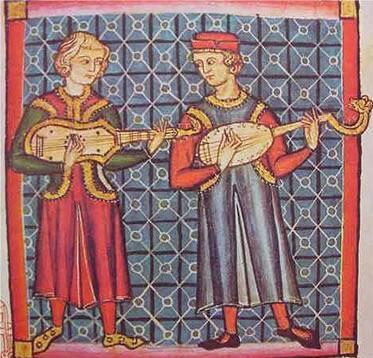
The guitarra latina and guitarra morisca (pictured) were medieval instruments of Spain, the former being the citole from the Roman Empire and the latter being the qanbus/gambus from the Moorish conquest of Andalusia.
The guitarra italiana was a 16th century lute with a longer neck. Lutes were ouds brought to Spain by Moors. Arabic "al'ud,' meaning "the wood" or "the fragrance" became laúd (Sp), luth (Fr), liuto (It), lute (En), etc.
The chitarrone of 17th century Italy, aka the theorbo, was literally a big chitarra (italiana). It was also used as a humanist symbol to replace the lyre or kithara of the classical Greek lyric poets. Thus, it is also symbolically a big kithara.
Todya's guitar took on its familiar waisted shape in 14th century Spain and France. Its rosette was Arabic, not like the citole's and gittern's, which were Gothic. To me this indicates its Moorish origin. Before that, I don't know, though I did find its tuning in an 11th century Persian oud treatise. That may be coincidence.
All Latin American guitars are derived from European ones. The Hawaiian ukulele that the Portuguese brought over, the cuatro venezolano and the Mexican jarana jarocha retain some of its old character from the 16th and 17th centuries.
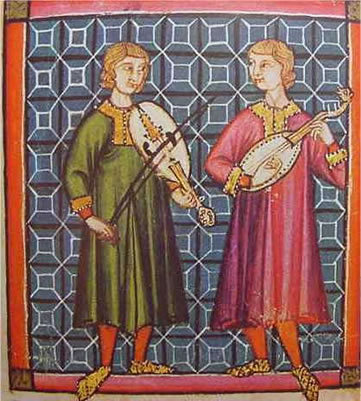
These images are from the Cantigas de Santa Maria, a medieval Spanish songbook.
These are vihuelas. Left is a vihuela de arco (bowed viol) and right is a vihuela de peñola (plectrum viol).
Vihuelas in Spain and viols in Italy were played da gamba (held by the legs) by the 15th century. The viola da gamba survives as the double bass viol (the orchestral contrabass).
The violin family took shape in 16th century Italy: violin (small viola), viola, violoncello aka cello (little big-viola), violone (big viola). In the 16th and 17th century, violone was a broad name for any large bowed viola. The double bass that survives to the present is part of the viol family (viola da gamba), not the violin family (violin, viola, cello).
In 16th century Spain and Italy, a waisted, flat-backed instrument called the vihuela de mano/viola da mano was used as an alternative to the bowl-backed lute. In Spain the lute/oud had Islamic connotations, and the vihuela Christian ones.
Portuguese, and subsequently Brazilians, called our guitar the violão. That name comes from this medieval tradition.
So: the words guitar and viol have both been applied, across different languages, to the instrument family now commonly known as the guitar. But, the word guitar also historically applied to citterns, and still does in Portugal, and the word viol used to be applied to guitar-like instruments, and still does in Portugal and Brazil.
#organology#guitar#viola#violin#guitarra#chitarra#violão#vihuela#vihuela de mano#viola da mano#lute#cittern#chitarrone#string instrument#chordophone#moorish#andalusia#moorish andalusia#qanbus#gambus#oud#al'ud#viola da gamba#violle#viol#violone#double bass#contrabass#string bass#bass guitar
18 notes
·
View notes
Text
Music History (Part 8): Pérotin
During the 1100's, a group of young composers at Notre-Dame de Paris became known for their radical approach to harmony. One of them was Léonin, who pioneered the technique of organum duplum – the plainchant melody is sung in the lower voice, using very long notes, and the upper voice sings shorter slurred notes (melismas) above it, following the same words.

Pascha Nostrum by Léonin, using organum duplum.
Léonin was the group's trailblazer, and he was well-known and admired within his lifetime. But it was his student Pérotin who took harmony even further.
Until now, composers had written music with only two parts, but Pérotin used three and four parts, thus creating chords (this was so new a concept at the time that there wasn't even a word for it). Because he was following his own path, he thought up complex, unusual note clusters, instead of going down the usual octave-fifth-fourth route. For decades and centuries afterwards, people would argue fiercely over what intervals & notes were an appropriate combination, and which chords were beautiful, ugly, discordant, etc. But Pérotin didn't care about any of this, and composed in a very freewheeling, sometimes out-of-control manner. Some of his combinations sound rather odd and like a mistake, but overall his harmony was incredible. A contemporary record refers to him as “Pérotin the Master”.
Pérotin's music was also influenced by the Arab world, because of the Crusades. In the 1100's, Paris and its university were expanding fast; the university was beginning to shake off its religious roots and take a more secular approach. It was the era of the troubadours and trouvères – composer-performers who travelled throughout France (especially Paris), singing songs of “refined” love.
The troubadours came from Occitania (Southern France, which had its own language & culture), and the trouvères from Northern France. Ideas and melodies were exchanged between the two regions, and also between sacred & secular music. Popular sacred melodies were used for folk songs, and popular secular tunes were added to existing plainchant. This sacred-secular exchange would continue for the next 300 years.
The troubadours were not a wholly French creation, but were inspired by the professional singers in the courts of al-Ándalus (i.e. Muslim Spain), whose capital was at Córdoba. The Crusaders of the 1000's & 1100's swept south, seizing provinces, plundering libraries, looting palaces and villas, and stealing treasures.
From this, three instruments came to Europe. The al'Ud (“strip of wood”) was from Persia, which developed into the lute and then the guitar. The rebab was a primitive type of violin. The qanun was a variant of the Ancient Greek psalterion (which the European psaltery had developed from).

Al’Ud.

Rebab.

Qanun.
The poetic songs of the Caliph's court were sometimes called ghinā'mutqan (“the perfect singing”), and came from a long tradition. There were professional women singers called qaynas, many of them slaves; and male composer-scholars such as Ibn Bājja (who was also known as Avenpace). In the final years of the al-Ándalus Caliphate, Arabic and European musicians mingled to create the zajal, a type of rhymed song.
The zajal was a crucial part of the growing troubadour repertoire. The melodies of these troubadour songs were shaped by their lyrics, and thus most of them had a gentle, foot-tapping pulse, even the sad songs.
So the musical situation in France, especially Paris, brought a new element to Pérotin's music: rhythm. It is true that the old plainchant had rhythm (all music does) but it wasn't an important or driving feature of the music, and composers didn't really think much about it.
#book: the story of music#music#music history#history#military history#christianity#islam#crusades#france#spain#al-ándalus#córdoba#léonin#pérotin#ibn bājja#singing#plainchant#troubadours#trouvères#ghinā'mutqan#zajal#al'ud#lute#guitar#rebab#violin#qanun#psalterion#psaltery
12 notes
·
View notes
Text
The oud is the queen of string instruments. There are varieties across the Arab, Persian, and Turkish world. The earliest oud may have been the Persian barbat - a lost instrument that is currently being reinvented and revived in Iran. Mythologically the oud was a gift from angels. Probably the real origin of all string instruments was the hunting bow. The oud is fretless (hasn't always been), and is thus able to relay the microtonally varied scalar inflections of each geographic region that plays it.
An Iranian friend once lent me his oud, and the strategic wear on its fingerboard showed me an exact imprint of the Iranian/Persian tuning aesthetic. That was a magic moment.
Here are two videos:
The first gives a very brief taste of the national inflections of oud playing across the Arab world. In reality the instruments themselves differ slightly.
1
The second video shows the difference of "quarter" tones in Arabic, Persian, and Turkish music.
2
3 notes
·
View notes
Text
By "lute" I refer broadly to a family of instruments with a neck and a bowl-shaped body that are plucked or strummed. Long-necked lutes seem to be oldest, with roots in Mesopotamia and Egypt.
The English word lute comes from the French luth and Spanish laúd, which come from the Arabic al'ud. The ud or oud came to Europe from the Middle East via Moorish Andalusia, and other variants spread across the Silk Road. The ud has formed migratory paths just as language families do. While the lute fell into near-disuse in Europe in the second half of the 18th century and has required a revival (what I do), it is still played in other parts of the world in unbroken traditions lasting millenia.
I will share some flavors, hopefully one every day for as long as my knowledge lasts.
This is the λαούτο laouto from mainland Greece. Crete has a larger variant. The laouto is also played in Cypress.
youtube
Now and henceforth, please refer to Youtube links for performer credits.
35 notes
·
View notes
Text
Arabs: al'ud
Greeks: LAOUTO
By "lute" I refer broadly to a family of instruments with a neck and a bowl-shaped body that are plucked or strummed. Long-necked lutes seem to be oldest, with roots in Mesopotamia and Egypt.
The English word lute comes from the French luth and Spanish laúd, which come from the Arabic al'ud. The ud or oud came to Europe from the Middle East via Moorish Andalusia, and other variants spread across the Silk Road. The ud has formed migratory paths just as language families do. While the lute fell into near-disuse in Europe in the second half of the 18th century and has required a revival (what I do), it is still played in other parts of the world in unbroken traditions lasting millenia.
I will share some flavors, hopefully one every day for as long as my knowledge lasts.
This is the λαούτο laouto from mainland Greece. Crete has a larger variant. The laouto is also played in Cypress.
youtube
Now and henceforth, please refer to Youtube links for performer credits.
35 notes
·
View notes